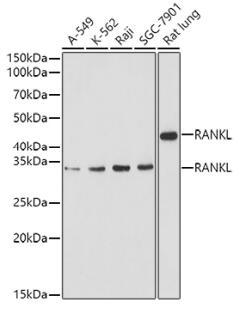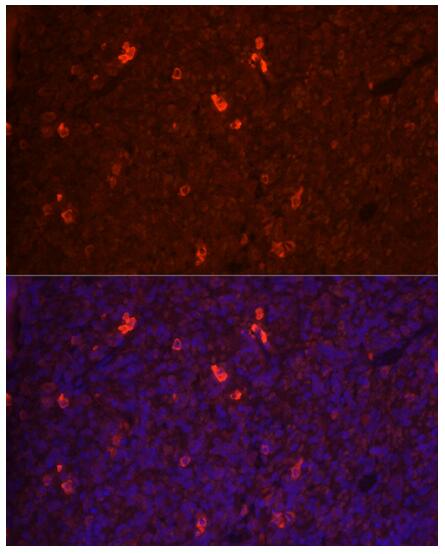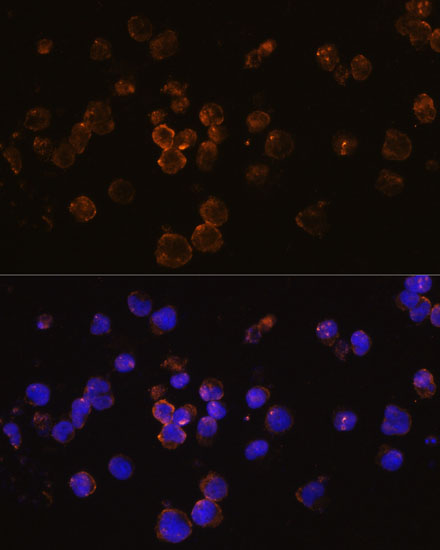Product Name :
RANKL polyclonal antibody Background :
This gene encodes a member of the tumor necrosis factor (TNF) cytokine family which is a ligand for osteoprotegerin and functions as a key factor for osteoclast differentiation and activation. This protein was shown to be a dentritic cell survival factor and is involved in the regulation of T cell-dependent immune response. T cell activation was reported to induce expression of this gene and lead to an increase of osteoclastogenesis and bone loss. This protein was shown to activate antiapoptotic kinase AKT/PKB through a signaling complex involving SRC kinase and tumor necrosis factor receptor-associated factor (TRAF) 6, which indicated this protein may have a role in the regulation of cell apoptosis. Targeted disruption of the related gene in mice led to severe osteopetrosis and a lack of osteoclasts. The deficient mice exhibited defects in early differentiation of T and B lymphocytes, and failed to form lobulo-alveolar mammary structures during pregnancy. Two alternatively spliced transcript variants have been found. Product :
Rabbit IgG, 1mg/ml in PBS with 0.02% sodium azide, 50% glycerol, pH7.2 Storage&Stability :
Store at 4°C short term. Aliquot and store at -20°C long term. Avoid freeze-thaw cycles. Specificity :
Recombinant fusion protein containing a sequence corresponding to amino acids 78-317 of human RANKL Immunogen :
Recombinant fusion protein containing a sequence corresponding to amino acids 78-317 of human RANKL Conjugate :
Unconjugated Modification :
Unmodification
RANKL polyclonal antibody Background :
This gene encodes a member of the tumor necrosis factor (TNF) cytokine family which is a ligand for osteoprotegerin and functions as a key factor for osteoclast differentiation and activation. This protein was shown to be a dentritic cell survival factor and is involved in the regulation of T cell-dependent immune response. T cell activation was reported to induce expression of this gene and lead to an increase of osteoclastogenesis and bone loss. This protein was shown to activate antiapoptotic kinase AKT/PKB through a signaling complex involving SRC kinase and tumor necrosis factor receptor-associated factor (TRAF) 6, which indicated this protein may have a role in the regulation of cell apoptosis. Targeted disruption of the related gene in mice led to severe osteopetrosis and a lack of osteoclasts. The deficient mice exhibited defects in early differentiation of T and B lymphocytes, and failed to form lobulo-alveolar mammary structures during pregnancy. Two alternatively spliced transcript variants have been found. Product :
Rabbit IgG, 1mg/ml in PBS with 0.02% sodium azide, 50% glycerol, pH7.2 Storage&Stability :
Store at 4°C short term. Aliquot and store at -20°C long term. Avoid freeze-thaw cycles. Specificity :
Recombinant fusion protein containing a sequence corresponding to amino acids 78-317 of human RANKL Immunogen :
Recombinant fusion protein containing a sequence corresponding to amino acids 78-317 of human RANKL Conjugate :
Unconjugated Modification :
Unmodification
-
 Western blot analysis of extracts of various cell lines, using RANKL antibody at 1:1000 dilution.
Western blot analysis of extracts of various cell lines, using RANKL antibody at 1:1000 dilution. -
 Immunohistochemistry of paraffin-embedded human colon using RANKL Antibody at dilution of 1:100 (40x lens).
Immunohistochemistry of paraffin-embedded human colon using RANKL Antibody at dilution of 1:100 (40x lens). -
 Immunohistochemistry of paraffin-embedded human colon using RANKL Antibody at dilution of 1:100 (40x lens).
Immunohistochemistry of paraffin-embedded human colon using RANKL Antibody at dilution of 1:100 (40x lens).
Enhancement of osteogenesis post-splenectomy does not attenuate bone loss in ovariectomized rats
PMCID: Pubmed No.:25640957
Psoralidin, a prenylated coumestan, as a novel anti-osteoporosis candidate to enhance bone formation of osteoblasts and decrease bone resorption of osteoclasts
PMCID: Pubmed No.:28283388
Chitosan-gold nanoparticles mediated gene delivery of c-myb facilitates osseointegration of dental implants in ovariectomized rat
PMCID: Pubmed No.:30307328
Phelligridin D-loaded oral nanotube titanium implant enhances osseointegration and prevents osteolysis in rat mandible
PMCID: Pubmed No.:29648890
Baicalin Nanocomplexes with an In Situ-Forming Biomimetic Gel Implant for Repair of Calvarial Bone Defects via Localized Sclerostin Inhibition
PMCID: Pubmed No.:36753285
DIFFERENTIATED EMBRYONIC CHONDROCYTE EXPRESSED GENE-1 IS A CENTRAL SIGNALING COMPONENT IN THE DEVELOPMENT OF COLLAGEN-INDUCED RHEUMATOID ARTHRITIS
PMCID: Pubmed No.:36739947
Exposure of newborns to atmospherically relevant artificial particulate matter induces hematopoietic stem cell senescence
PMCID: Pubmed No.:37002998
Bioworld Biotech only provide peptides for our antibodies and do not provide additional peptide customization services.
Price/Size :
USD 368/1mg/vial
Tips:
For phospho antibody, we provide phospho peptide(0.5mg) and non-phospho peptide(0.5mg).Describe :
Blocking peptides are peptides that bind specifically to the target antibody and block antibody binding. These peptide usually contains the epitope recognized by the antibody. Antibodies bound to the blocking peptide no longer bind to the epitope on the target protein. This mechanism is useful when non-specific binding is an issue, for example, in Western blotting (WB) and Immunohistochemistry (IHC). By comparing the staining from the blocked antibody versus the antibody alone, one can see which staining is specific; Specific binding will be absent from the western blot or IHC performed with the neutralized antibody.Formula:
Synthetic peptide was lyophilized with 100% acetonitrile and is supplied as a powder. Reconstitute with 0.1 ml DI water for a final concentration of 10 mg/ml.The purity is >90%,tested by HPLC and MS.
Storage:
The freeze-dried powder is more stable. For short time at 2-8°C. For long term storage store at -20°C.
Note :
This product is for research use only (RUO only). Not for use in diagnostic or therapeutic procedures.
 RANKL polyclonal antibody
RANKL polyclonal antibody  Datasheet
Datasheet COA
COA MSDS
MSDS SHIP
SHIP